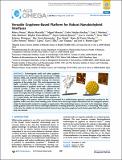Por favor, use este identificador para citar o enlazar a este item:
http://hdl.handle.net/10261/187429COMPARTIR / EXPORTAR:
 SHARE SHARE
 CORE
BASE CORE
BASE
|
|
| Visualizar otros formatos: MARC | Dublin Core | RDF | ORE | MODS | METS | DIDL | DATACITE | |

| Título: | Versatile Graphene-Based Platform for Robust Nanobiohybrid Interfaces |
Autor: | Bueno, Rebeca A.; Marciello, Marzia CSIC ORCID; Moreno, Miguel; Sánchez-Sánchez, Carlos CSIC ORCID ; Martínez, José I. CSIC ORCID ; Martínez-Orellana, Lidia CSIC ORCID ; Prats Alfonso, Elisabet CSIC ORCID; Guimerà-Brunet, Anton CSIC ORCID; Garrido, Jose A. CSIC ORCID; Villa, Rosa CSIC ORCID ; Mompean, F. J. CSIC ORCID; García-Hernández, Mar CSIC ORCID ; Huttel, Yves CSIC ORCID ; Morales, M. P. CSIC ORCID ; Briones, Carlos CSIC ORCID; López, María Francisca CSIC ORCID ; Ellis, Gary James CSIC ORCID ; Vázquez, Luis CSIC ORCID ; Martín-Gago, José A. CSIC ORCID | Fecha de publicación: | 14-feb-2019 | Editor: | American Chemical Society | Citación: | ACS Omega 4(2): 3287-3297 (2019) | Resumen: | Technologically useful and robust graphene-based interfaces for devices require the introduction of highly selective, stable, and covalently bonded functionalities on the graphene surface, whilst essentially retaining the electronic properties of the pristine layer. This work demonstrates that highly controlled, ultrahigh vacuum covalent chemical functionalization of graphene sheets with a thiol-terminated molecule provides a robust and tunable platform for the development of hybrid nanostructures in different environments. We employ this facile strategy to covalently couple two representative systems of broad interest: metal nanoparticles, via S–metal bonds, and thiol-modified DNA aptamers, via disulfide bridges. Both systems, which have been characterized by a multitechnique approach, remain firmly anchored to the graphene surface even after several washing cycles. Atomic force microscopy images demonstrate that the conjugated aptamer retains the functionality required to recognize a target protein. This methodology opens a new route to the integration of high-quality graphene layers into diverse technological platforms, including plasmonics, optoelectronics, or biosensing. With respect to the latter, the viability of a thiol-functionalized chemical vapor deposition graphene-based solution-gated field-effect transistor array was assessed. | Versión del editor: | https://doi.org/10.1021/acsomega.8b03152 | URI: | http://hdl.handle.net/10261/187429 | DOI: | 10.1021/acsomega.8b03152 | E-ISSN: | 2470-1343 |
| Aparece en las colecciones: | (ICTP) Artículos (ICMM) Artículos (CIN2) Artículos (CAB) Artículos (IMB-CNM) Artículos |
Ficheros en este ítem:
| Fichero | Descripción | Tamaño | Formato | |
|---|---|---|---|---|
| acsomega.8b03152.pdf | 5,51 MB | Adobe PDF |  Visualizar/Abrir |
CORE Recommender
PubMed Central
Citations
5
checked on 18-abr-2024
SCOPUSTM
Citations
8
checked on 11-abr-2024
WEB OF SCIENCETM
Citations
6
checked on 21-feb-2024
Page view(s)
300
checked on 19-abr-2024
Download(s)
189
checked on 19-abr-2024
Google ScholarTM
Check
Altmetric
Altmetric
Artículos relacionados:
NOTA: Los ítems de Digital.CSIC están protegidos por copyright, con todos los derechos reservados, a menos que se indique lo contrario.
